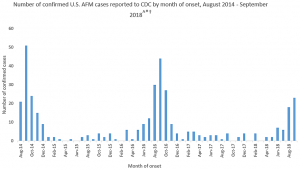Return of Polio? Six studies linking Acute Flaccid Myelitis to vaccines

According to the CDC, from August 2014 through September 2018, information on a total of 386 confirmed cases of AFM across the US has been received, with most of the cases occurring in children. So far, 2018 has seen children stricken with AFM in Colorado, Minnesota, Illinois, Pennsylvania, Texas, and Washington. However, in the 1950’s all of them would have been diagnosed as polio.
“Like polio, AFM affects the body’s nervous system — specifically, the spinal cord — and can cause paralysis. What we do not know: the exact cause of the illness, though scientists think it is most likely the result of a viral infection. Other potential culprits include environmental toxins, genetic disorders, and Guillain-Barré syndrome, according to the CDC.”1
RELATED STORY:
So just what is Acute Flaccid Myelitis? According to the Transverse Myelitis Association:
“Acute Flaccid Myelitis (AFM) is a variant or sub-type of transverse myelitis. AFM is inflammation of the spinal cord and generally presents with unique clinical and MRI features that are not typical of classical transverse myelitis. AFM abnormalities noted on MRI are predominantly found in the gray matter of the spinal cord. In 2013, an outbreak of what is now believed to be this sub-type of transverse myelitis occurred in California and more cases were reported in the summer and fall of 2014 across the United States. The enterovirus (EV-D68) has been suspect in many of these cases however, it has not been definitively proven that it is this particular virus that has caused the paralysis,1 although several cases of AFM occurred at around the same time as an outbreak of the EV-D68 virus.”2
AFM is one form of Transverse Myelitis.
RELATED STORY:
And while it is a rare condition, there are vaccines associated with AFM. Particularly the flu shot.
“A systematic review of PubMed, EMBASE, and DynaMed for all English-language journals published between 1970 and 2009 was performed, utilizing the keywords transverse myelitis, myelitis, vaccines, post-vaccination, vaccination, and autoimmunity. We have disclosed 37 reported cases of transverse myelitis associated with different vaccines including those against hepatitis B virus, measles-mumps-rubella, diphtheria-tetanus-pertussis, and others, given to infants, children, and adults. In most of these reported cases, the temporal association was between several days and 3 months, although a longer time frame of up to several years was also suggested. Although vaccines harbor a major contribution to public health in the modern era, in rare cases they may be associated with autoimmune phenomena such as transverse myelitis. The associations of different vaccines with a single autoimmune phenomenon allude to the idea that a common denominator of these vaccines, such as an adjuvant, might trigger this syndrome.”3
And then there are the six studies that link acute myelitis (aka paralysis) to vaccines:4
1. “In fact, a number of inflammatory disorders of the central nervous system [myelitis] have been associated with the administration of various vaccines.” — www.ncbi.nlm.nih.gov/pubmed/27023738
2. “We reviewed the magnetic resonance imaging (MRI) database of the Dent Neurologic Institute to study the abnormal findings in myelitis. We identified 9 patients, with acute transverse myelitis. Although readily distinguishable from lesions due to MS, the various etiologies for ATM, including post-infectious (n = 2), post-vaccination (n = 3), and idiopathic (n = 4) were indistinguishable on MRI.”
— www.ncbi.nlm.nih.gov/pubmed/10210810
— www.ncbi.nlm.nih.gov/pubmed/10210810
3. “It should be recognized that certain vaccines might trigger serious neurological immune phenomena such as Guillain-Barre syndrome, seizures, cranial neuropathy, and acute disseminated encephaloMYELITIS (ADEM). Here we report on an elderly woman with ADEM following seasonal influenza [flu] vaccination.” — www.ncbi.nlm.nih.gov/pmc/articles/PMC3889594/
4. “A wide variety of inflammatory diseases temporally associated with the administration of various vaccines, has been reported in the literature. The most commonly reported vaccinations that were associated with CNS demyelinating diseases included influenza (21 cases), human papilloma virus (HPV) (9 cases), hepatitis A or B (8 cases), rabies (5 cases), measles (5 cases), rubella (5 cases), yellow fever (3 cases), anthrax (2 cases), meningococcus (2 cases) and tetanus (2 cases). Usually the symptoms of the CNS demyelinating syndrome appear a few days following the immunization (average: 14.2 days).
— www.ncbi.nlm.nih.gov/pubmed/24514081
— www.ncbi.nlm.nih.gov/pubmed/24514081
5. “We describe two adult cases of neurologic complications occurring after influenza vaccination. The first case was a 62-year-old man who experienced convulsions 5 days after vaccination, and the second case was a 70-year-old man who exhibited paraplegia 7 days after vaccination. Diagnoses of acute disseminated encephalomyelitis and transverse MYELITIS with acute motor axonal neuropathy were made.”
— www.ncbi.nlm.nih.gov/pubmed/12636241
— www.ncbi.nlm.nih.gov/pubmed/12636241
6. “Acquired Demyelinating disorders [MYELITIS] of the central nervous system in children span a wide spectrum. The etiology of acquired demyelinating conditions is multi-factorial namely – genetic, post-infectious, post-immunization…Vaccines, specifically influenza, rabies, and smallpox vaccines have also been reported.” — www.ncbi.nlm.nih.gov/pubmed/24514081/
And don’t forget the CDC data that shows heavy concentrations of cases, mostly in children, during the months of August-October (back to school shots).

Please, please, please do some research before you decide to vaccinate your child. Especially before vaccinating against influenza or HPV.
No comments:
Post a Comment